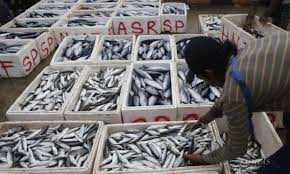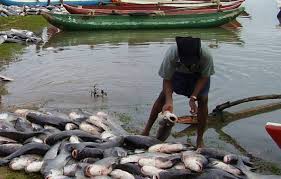The laws governing natural resources in Nigeria include the Exclusive Economic Zone Decree of 1978, the Sea Fisheries Decree, and several others that regulate these resources. There is a need to enforce these laws to ensure the proper functioning of the fisheries sector.
Several decrees and laws, both national and international, have been enacted in response to the need for better fisheries management in Nigeria. These include the following:
National Fisheries Decrees and Regulations
1. Exclusive Economic Zone Decree No. 28 of 1978: This decree defines the exclusive economic zone (EEZ) of Nigeria as an area extending from the external limits of the territorial waters of Nigeria up to 200 nautical miles seawards from the baseline, in accordance with the provisions of the UN Convention on the Law of the Sea. Within this zone, Nigeria exercises sovereign rights in the areas of policing, exploration, conservation, and exploitation of natural resources, including fish and shellfish.
Sea Fisheries Decrees of 1971 and 1972: The Sea Fisheries Decrees of 1971 and 1972 were created to regulate the following:
i. The registration and licensing of fishing trawlers operating in Nigerian coastal waters.
ii. The 1971 decree prohibited the use of explosives and poisons for catching fish.
iii. According to the 1972 Sea Fisheries Decree: Trawlers were prohibited from operating within the first two nautical miles of the continental shelf to prevent competition with small-scale artisanal fisheries.
The minimum cod-end mesh size of trawl nets was set at 3.5 inches (76 mm) for finfish and 1.75 inches (44 mm) for shrimp. Shrimp trawlers were prevented from operating within the inshore waters of the Lagos-West fishing grounds to protect juvenile croakers common in the area.
Read Also: How to Grow Paw-Paw (papayas): Beginners Business Guide
Sea Fisheries Decree No. 71 of 1992

The Sea Fisheries Licensing Regulation of 1992 outlined conditions for granting fishing licenses for shrimp harvests and fishing. It required an application for pre-purchase assurance and the submission of feasibility studies.
It also prohibited the operation of unregistered and unlicensed motorized fishing boats for fishing or reefer vessels for discharging frozen fish within Nigerian territorial waters or its EEZ. The decree recognized the Minister responsible for fisheries as the licensing officer and ensured that motorized fishing operations did not negatively impact Nigeria’s sea fishing industry.
The Sea Fisheries (Licensing) Regulations of 1992 provided conditions for licensing, approved types of motor fishing boats for use in Nigeria’s territorial waters, and the validity of licenses.
The Sea Fisheries (Fishing) Regulations of 1992** had the following functions:
- Provided guidelines on restricted areas for trawling and navigating.
- Specifications for trawl nets and fishing vessels.
- Regulations on the landing of catches and size limits for sale.
- Adjudication powers.
The decree authorized the Nigerian Institute for Oceanography and Marine Research (NIOMR), Lagos, to publish the minimum total length for various species.
Sea Fisheries (Fish Inspection and Quality Assurance) Regulations of 1995
This regulation institutionalized fish inspection and quality assurance in Nigeria. Emphasis was placed on the mode of transportation, handling, storage, and sale of fish imported to or exported from Nigeria.
Inland Fisheries Decree No. 108 of 1992
The Inland Fisheries Decree was enacted to harmonize the administration, management, protection, and improvement of inland water fisheries. The roles of the decree included:
- Licensing and identification of fishing craft.
- Restrictions on the use of certain fishing gear.
- Prohibition of harmful fishing methods.
- Prevention of unauthorized export or import of live fish.
- Protection of fish products from contamination and infection.
State Commissioners of Agriculture were tasked with regulating the activities of the fisheries sector in inland waters under this Act.
1. Inland Fisheries (Fish Quality Assurance) Regulations of 1995:
This regulation provided guidelines on the transportation, handling, preservation, and marketing of fish caught from inland waters in Nigeria.
2. Turtle Excluder Device Regulations of 1996: This regulation enforced the use of by-catch reduction devices in industrial fisheries.
3. Land Use Act of 1978: State Governors were authorized to grant statutory rights of occupancy for land use. The licensing system regulated the diversion, storage, and use of water for commercial purposes, particularly concerning the construction, maintenance, and operation of hydraulic works, though no reference was made to aquaculture.
Interim Guidelines and Standards for Environmental Pollution Control in Nigeria (1991)

These guidelines and standards, set by the Federal Environmental Protection Agency of Nigeria, covered six areas of environmental pollution control:
- Effluent limitations.
- Water quality for industrial use at points of intake.
- Industrial emission limitations.
- Noise exposure limitations.
- Management of solid and hazardous wastes.
- Pollution abatement in industries (LEX-FAO, 2014).
Water Resources Decree of 1993
The Federal Ministry of Water Resources developed the Water Resources Decree No. 101 of 1993 to provide the legal framework for water resources development in Nigeria.
This decree assigned the responsibility for developing the nation’s water resources to the Ministry of Water Resources and Rural Development. Nigeria’s Water Resources Master Plan for 1995-2020 was completed with technical assistance from the Japanese International Cooperation Agency (JICA) between 1992 and 1995.
The National Water Supply Policy, completed and approved in 1995, provided guidelines for water supply development up to 2015 (UN Agenda 21, 1997).
1. Aquaculture Legislation:
According to FAO (2013), Nigeria has no specific legislation regarding aquaculture at the national level. While it is not directly mentioned in the Sea Fisheries Decrees of 1971 and 1992, the Minister of Fisheries may determine whether enclosures, pens, and cages should be subjected to license fees.
Read Also: How To Grow Apple Trees
International Laws and Legislation on Fisheries

i. United Nations Convention on the Law of the Sea (1982)
This convention, which entered into force in 1984, governs the marine environment and its resources.
ii. Convention on Biological Diversity
This binding agreement obligates parties to:
1.Conserve biodiversity.
- Ensure the sustainable use of biodiversity components.
- Share the benefits of genetic resource utilization fairly and equitably.
iii. FAO Code of Conduct for Responsible Fisheries:
Adopted in 1995, this voluntary agreement outlines principles and standards for responsible fisheries practices, ensuring the effective conservation, management, and development of aquatic resources with respect for ecosystems and biodiversity.
Nigeria is also a member of several international groups, including:
i. World Trade Organization (WTO).
ii. The Biosafety Protocol.
iii. The Convention on International Trade in Endangered Species of Wild Flora and Fauna (CITES).
iv. Revised Convention for the Establishment of the Niger Basin Authority (1987), replacing the Niger River Commission, and the Convention and Statutes for the development of the Chad Basin Commission.
Do you have any questions, suggestions, or contributions? If so, please feel free to use the comment box below to share your thoughts. We also encourage you to kindly share this information with others who might benefit from it. Since we can’t reach everyone at once, we truly appreciate your help in spreading the word. Thank you so much for your support and for sharing!
Read Also: Advantages of Waste Recycling

